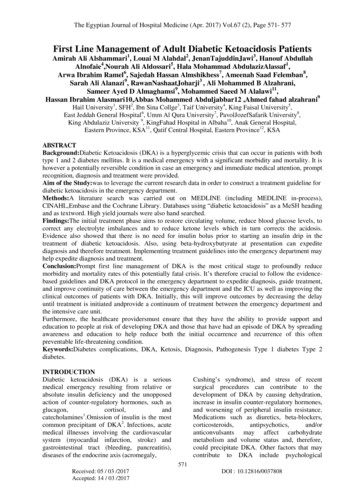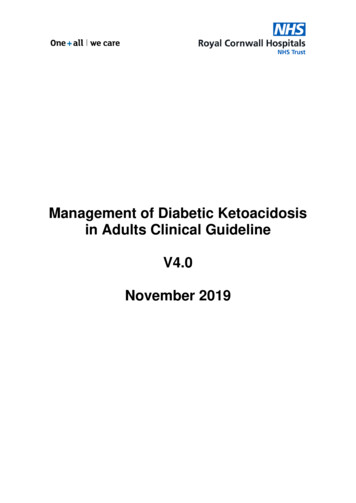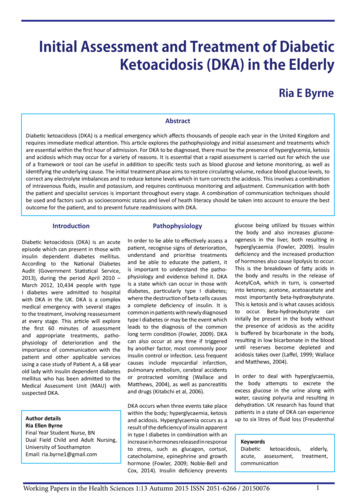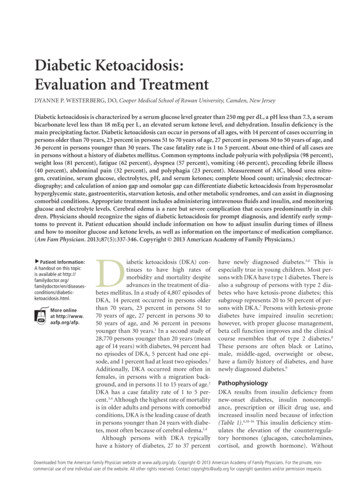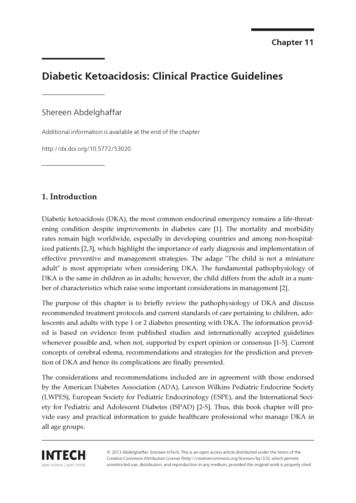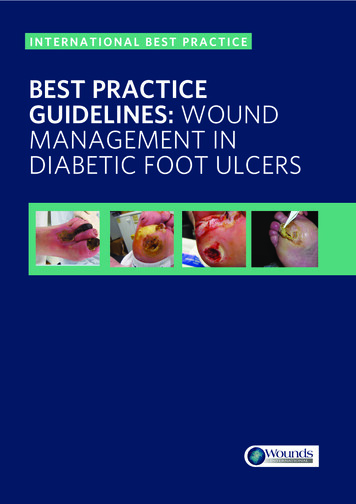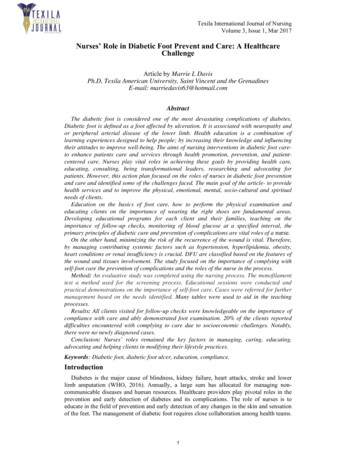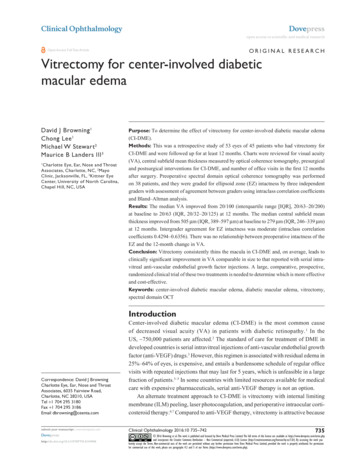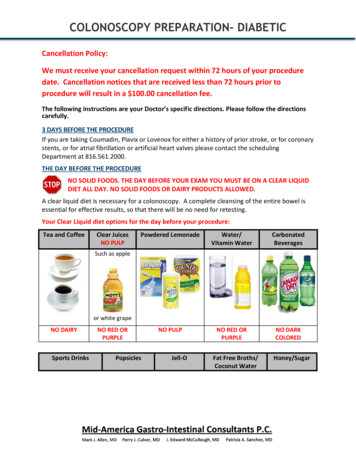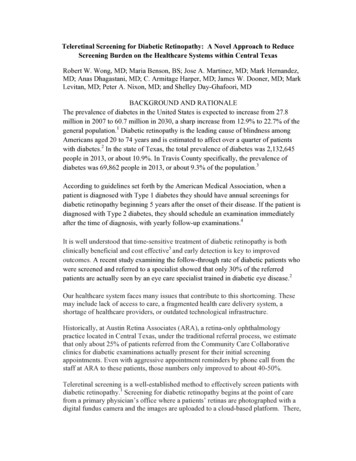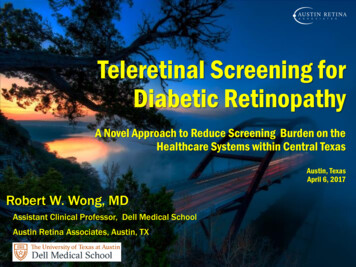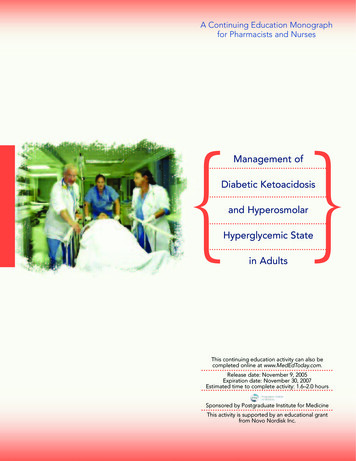
Transcription
A Continuing Education Monographfor Pharmacists and Nurses{ }Management ofDiabetic Ketoacidosisand HyperosmolarHyperglycemic Statein AdultsThis continuing education activity can also becompleted online at www.MedEdToday.com.Release date: November 9, 2005Expiration date: November 30, 2007Estimated time to complete activity: 1.6–2.0 hoursSponsored by Postgraduate Institute for MedicineThis activity is supported by an educational grantfrom Novo Nordisk Inc.
Program GoalEducational ObjectivesThis monograph is a review of the pathophysiology,diagnosis, treatment, and complications of diabeticketoacidosis (DKA) and hyperosmolar hyperglycemicstate (HHS) in adults.After completing this educational activity, participantsshould be able to:This educational activity has been designed to meet theeducational needs of pharmacists and registered nursesinvolved in the management of patients with diabetes. Differentiate between DKA and HHS Describe the epidemiology and pathophysiology of DKA Identify the signs, symptoms, and complications of DKA Discuss methods of treatment and recovery care for DKA Describe potential complications during treatment ofDKA and special considerations for pregnant andelderly individuals Provide strategies for the prevention of DKAPurposeEditorial Review BoardProvide clinicians treating patients with diabetes thelatest information about the pathophysiology, diagnosis,and management of DKA and HHS to help reduce theincidence, morbidity, and mortality of the disorder.John B. Buse, MD, PhD, FACETarget AudienceChief, Division of General Internal MedicineDirector, Diabetes Care CenterUniversity of North Carolina School of MedicineChapel Hill, North CarolinaStatement of Need/Program OverviewDKA and HHS are life-threatening emergencies and arethe most serious complications of diabetes. DKA is causedby relative or absolute insulin deficiency, which results inhyperglycemia, ketonemia, dehydration, electrolyteimbalances, and acidosis. Treatment protocols for adultsgenerally advocate a more rapid and aggressive reversalof DKA than is advised for children. DKA consumes asignificant proportion of all direct medical costs for adultsand children with type 1 diabetes. The management ofDKA requires a full complement of hospital, emergency,and intensive care services. In the United States, morethan 100,000 individuals are hospitalized each year forDKA and the mortality rate is 2% to 5%.Most cases of DKA can be prevented by using an effectivediabetes management plan that includes patient self-care.Early identification of precipitating signs and symptomsand prompt, appropriate intervention can reduce thefrequency of DKA episodes that result in a medicalemergency.The healthcare team must stay informed about the recentdevelopments in diabetes care and have the necessaryclinical skills to prevent and manage DKA episodes.Through good self-management and intensive glycemiccontrol, the incidence, morbidity, and mortality of DKAcan be reduced.Marsha Menke, RN, BSN, MS, CDE, CPTDirector, Diabetes Care CenterGenesis Medical CenterDavenport, IowaThomas S. Sisca, PharmD, FCCP, BCPSClinical Pharmacist, Antithrombosis SpecialistAntithrombosis Services/Anticoagulation ClinicShore Health SystemMemorial HospitalEaston, MarylandPharmacist Continuing EducationAccreditation StatementPostgraduate Institute for Medicine isaccredited by the Accreditation Councilfor Pharmacy Education as a provider ofcontinuing pharmacy education.Credit DesignationPostgraduate Institute for Medicine designates this continuingeducation activity for 1.6 contact hours (0.16 CEU) of theAccreditation Council for Pharmacy Education.Universal Program Number – 809-999-05-064-H01.{i}
Nursing Continuing EducationCNA/ANCCThis educational activity for 2.0 contact hours is providedby the Postgraduate Institute for Medicine (PIM). ThePostgraduate Institute for Medicine is approved as aprovider of continuing education in nursing by theColorado Nurses Association, which is accredited asan approver of continuing education in nursing by theAmerican Nurses Credentialing Center’s Commissionon Accreditation.California Board of Registered NursingPostgraduate Institute for Medicine is approved by theCalifornia Board of Registered Nursing, Provider Number13485 for 2.0 contact hours.Disclosure of Conflicts of InterestPostgraduate Institute for Medicine (PIM) assesses conflictof interest with its instructors, planners, managers, andother individuals who are in a position to control thecontent of CME activities. All relevant conflicts of interestthat are identified are thoroughly vetted by PIM for fairbalance, scientific objectivity of studies utilized in thisactivity, and patient care recommendations. PIM iscommitted to providing its learners with high-qualityCME activities and related materials that promoteimprovements or quality in healthcare and not a specificproprietary business interest of a commercial interest.Method of ParticipationThere are no fees for participating and receiving CE creditfor this activity. During the period November 9, 2005through November 30, 2007, participants must: 1) read thelearning objectives and faculty disclosures; 2) study theeducational activity; 3) complete the post-test by recordingthe best answer to each question in the answer key onthe evaluation form; 4) complete the evaluation form; and5) mail or fax the evaluation form with answer key to thePostgraduate Institute for Medicine.A statement of credit will be issued only upon receipt ofa completed activity evaluation form and a completedpost-test with a score of 70% or better. Your statement ofcredit will be mailed to you within 3 weeks.MediaMonographDisclosure of Unlabeled UseThis educational activity may contain discussion ofpublished and/or investigational uses of agents that arenot indicated by the US Food and Drug Administration.Postgraduate Institute for Medicine (PIM), Scherer ClinicalCommunications, and Novo Nordisk Inc. do not recommendthe use of any agent outside of the labeled indications.The opinions expressed in the educational activity arethose of the faculty and do not necessarily represent theviews of PIM, Scherer Clinical Communications, andNovo Nordisk Inc. Please refer to the official prescribingThe following faculty reported a real or apparent conflict of interest:NAME OF FACULTY OR PRESENTERREPORTED AREAS OF CONFLICTJohn B. Buse, MD, PhD, FACEConsulting Fees: Amylin, BD, Eli Lilly and Company, InsuletResearch: Amylin, BD, Dexcom, Eli Lilly and Company, Sanofi-AventisOwnership/Stocks: InsuletMarsha Menke, RN, BSN, MS, CDE, CPTNo significant financial relationships related to this activityThomas S. Sisca, PharmD, FCCP, BCPSConsulting Fees: Sanofi-Aventis, Bristol-Myers SquibbThe following planners and managers reported a real or apparent conflict of interest:NAME OF PLANNER OR MANAGERREPORTED AREAS OF CONFLICTPeter MacholdtNo financial relationships related to this activityJan Hixon, RN, MSNNo financial relationships related to this activity{ ii }
information for each product for discussion of approvedindications, contraindications, and warnings.DisclaimerParticipants have an implied responsibility to use thenewly acquired information to enhance patient outcomesand their own professional development. The informationpresented in this activity is not meant to serve as aguideline for patient management. Any procedures,medications, or other courses of diagnosis or treatmentdiscussed or suggested in this activity should not beused by clinicians without evaluation of their patient’sconditions and possible contraindications on dangers inuse, review of any applicable manufacturer’s productinformation, and comparison with recommendations ofother authorities.Copyright 2005, Scherer Clinical Communications.All rights reserved.Published by Scherer Clinical Communications117 West Prospect Street, Hopewell, NJ 08525Printed in USA.{ iii }
Table of n3Ketone production3Ionic changes3–4Compensatory Attempts4TRIGGERS OF DKA AND HHS4–5WARNING SIGNS AND SYMPTOMS5–6DIAGNOSIS6Anion Gap6–7TREATMENT GUIDELINES7–10RECOVERY CARE10ELECTROLYTE MANAGEMENT DURING patient prevention measures12Preventing recurrent diabetic ketoacidosis12SPECIAL CIRCUMSTANCES12Pregnancy12Elderly12ECONOMIC ISSUES13SUMMARY13APPENDIX A14APPENDIX B15REFERENCES16POST-TEST17–18EVALUATION FORM19–20{ iv }
IntroductionEach year more than 100,000 people are hospitalized fordiabetic ketoacidosis (DKA) in the United States, resultingin cumulative annual hospital costs that may be morethan 1 billion.1 DKA is a life-threatening illness, and themortality rate for DKA, estimated between 2% to 5%, hasremained relatively unchanged since the 1970s.2,3 Theaverage length of hospital stay for patients diagnosedwith DKA, however, has declined from 7.9 days in 1980 to3.9 days in 2002.4 More than 25% of the costs for directmedical care for adults with type 1 diabetes covers DKA;this increases to 50% in those experiencing recurrentepisodes.5Among the benefits of effective glycemic control isreduced incidence of DKA or hyperosmolar hyperglycemicstate (HHS) and associated morbidity and mortality. BothDKA and HHS are life-threatening emergencies.6,7 TheAmerican Diabetes Association (ADA) recommends thatadults with diabetes maintain preprandial plasma glucoselevels between 90 and 130 mg/dL, postprandial levels 180 mg/dL, and an A1C 7% while pointing out thatmore stringent glycemic goals (ie, a normal A1C 6%)may further reduce complications at the cost of increasedrisk of hypoglycemia.8 The American College ofEndocrinology has somewhat different targets, recommending preprandial plasma glucose levels 110 mg/dL,postprandial levels 140 mg/dL, and an A1C 6.5%.9Comprehensive education in self-management is a criticalelement for achieving and maintaining optimal glycemiccontrol. The physician and patient must set realistictreatment goals with the diabetes management team andfamily members. An effective program requires ongoingsupport from the clinical care team.Healthcare professionals who treat patients with diabetesmust know how to prevent and manage DKA. This monograph defines DKA and describes symptoms and warningsigns, diagnosis, current practices, complications, preventionmethods, special circumstances, and economic issues.DefinitionDKA is a reversible but life-threatening complication thatresults from relative or absolute insulin deficiency.10 In theabsence of insulin, most cells cannot use glucose. Fatbreakdown provides an alternative source of energy.These metabolic abnormalities will, if not reversed,culminate in DKA, which is characterized by the presenceof hyperglycemia, ketosis, and acidosis (Figure 1). Thecommon signs and symptoms of DKA include “fruity”(acetone) breath secondary to ketosis, nausea, vomiting,polydipsia, and polyuria. Breathing becomes deep andrapid as the body attempts to correct the acidosis(Kussmaul’s respiration). HHS is also a life-threateningcondition arising from insufficiency of insulin action,leading to increased levels of counterregulatory hormones,alterations in osmolality, and hyperglycemia; however,HHS lacks the marked lipolysis, ketonemia, and acidosisassociated with DKA.1 DKA and HHS represent twoextremes on the spectrum of decompensated diabetes;they differ by magnitude of hyperglycemia, severity ofacidosis/ketonemia, and degree of dehydration.7 Table 1summarizes the diagnostic criteria distinguishing DKAfrom HHS.HYPERGLYCEMIC STATES Diabetes Mellitus Hyperosmolar Hyperglycemic State Impaired Glucose Tolerance Stress HyperglycemiaMETABOLIC ACIDOTIC STATES Lactic Acidosis Hyperchloremic Acidosis Uremic Acidosis Drug-Induced Acidosis(eg, salicylates, methanol,ethylene glycol)HYPERGLYCEMIAACIDOSISDKAKETOSISKETOTIC STATES Ketotic Hypoglycemia Alcoholic Ketosis Starvation KetosisFigure 1. Diagnostic triad of diabetic ketoacidosis (DKA).From Kitabchi AE. Diabetes mellitus. In: Glew RH, Peters SP, eds. Clinical Studiesin Medical Biochemistry. New York, NY: Oxford University Press; 1987:102–117.Both DKA and HHS can occur in patients with type 1 ortype 2 diabetes.1 DKA frequently affects young patientswith type 1 diabetes on initial presentation; however, itdoes occur in patients with type 2 diabetes and in adultsas well.1,3,11–14 HHS occurs most commonly in older adultswith type 2 diabetes.13,15 In HHS, insulin resistance andrelative insulin deficiency, which are usually a result of aprecipitating factor (eg, stroke, infection, myocardialinfarction), can result in high levels of blood glucose.Because HHS generally occurs in patients with type 2diabetes who are capable of some insulin production,marked ketosis and attendant acidosis are not usuallypresenting clinical features. HHS and DKA can coexist,however, which can make differential diagnosis difficult.16HHS is often triggered by glucosuric diuresis.17 The onsetof DKA is typically more acute than that of HHS, with{1}
symptoms often developing over a course of hours, asopposed to days to weeks for HHS.1,13,18 The severity ofDKA depends on the magnitude of the decrease inarterial pH, serum bicarbonate, and mental state ratherthan hyperglycemia (Table 1).The severe hyperglycemic and hyperosmolar (concentratedserum) state associated with HHS typically leads to profounddehydration and confusion or coma. The excessive waterloss through osmotic diuresis can be a vicious cycle, whichcan only be compensated by adequate fluid replacement.16Common signs of HHS include stupor, dehydration, andhypotension. The neurologic signs can range from aphasiato seizures or coma. Patients often present with weakness,visual disturbance, or leg cramps.17Table 1. Diagnostic Criteria for DiabeticKetoacidosis (DKA) and HyperosmolarHyperglycemic State (HHS).DKAMildPlasma glucose(mg/dL)Arterial pHSerum bicarbonate(mEq/L) 250HHSMo
09.11.2005 · diagnosis, treatment, and complications of diabetic ketoacidosis (DKA) and hyperosmolar hyperglycemic state (HHS) in adults. Target Audience This educational activity has been designed to meet the educational needs of pharmacists and registered nurses involved in the management of patients with diabetes. Purpose Provide clinicians treating patients with diabetes the latest information about .
